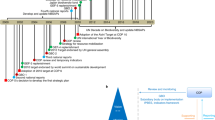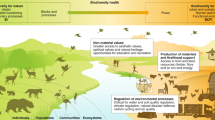Abstract
Finance will be among the priority concerns when the United Nations Convention on Biological Diversity launches the post-2020 framework for global biodiversity conservation (Global Biodiversity Framework) in 2021. The Biodiversity Finance Initiative provides a means for countries to account systematically for their biodiversity expenditures. A sample of 30 countries facilitated the construction of a panel to better understand the effectiveness of public biodiversity investments. Overall, the results show a positive trend in national public biodiversity investments and that larger economies invest more in biodiversity in gross magnitude and as a percentage of gross domestic product (GDP) (0.30% of GDP among wealthy countries versus 0.29%) and of national budgets (1.78% versus 1.14%). Controlling for GDP, wealthier countries invest proportionately less than less wealthy countries. The relationship between GDP and public biodiversity expenditure is an inverted-U curve. All biodiversity-related variables (threatened species, protected area and the presence of a hotspot) were positively correlated with public biodiversity investments. Funds allocated to biodiversity are associated with a reduction in the number of threatened species and the rate of biodiversity loss of about 1% per year. Each US$1 billion investment in biodiversity is associated with an annual reduction in the proportion of threatened to total species of about 0.57%. Population growth is associated with lower financial support for biodiversity and an increase in the proportion of threatened to total species in a country.
This is a preview of subscription content, access via your institution
Access options
Access Nature and 54 other Nature Portfolio journals
Get Nature+, our best-value online-access subscription
$29.99 / 30 days
cancel any time
Subscribe to this journal
Receive 12 digital issues and online access to articles
$119.00 per year
only $9.92 per issue
Buy this article
- Purchase on Springer Link
- Instant access to full article PDF
Prices may be subject to local taxes which are calculated during checkout


Similar content being viewed by others
Data availability
The secondary datasets of public data compiled and generated during and/or analysed during the current study are available in Supplementary Data 1. The primary country expenditure data compiled and analysed during the current study are not available due to standard survey research protocols protecting individual respondents but will be made available to check or replicate our results from the corresponding author under conditions that individual country responses are not divulged.
References
Huwyler, F., Kappeli, J., Serafimova, K., Swanson, E. & Tobin, J. Conservation Finance: Moving Beyond Donor Funding Toward an Investor-driven Approach (WWF, Credit Suisse and McKinsey & Company, 2014); http://go.nature.com/2Ka5Y2u
Deutz, A. et al. Financing Nature: Closing the Global Biodiversity Financing Gap: Full Report (Paulson Institute, Nature Conservancy and Cornell Atkinson Center for Sustainability, 2020).
Halpern, B. et al. Gaps and mismatches between global conservation priorities and spending. Conserv. Biol. 20, 56–64 (2006).
James, A., Gaston, K. J. & BalmfordA. Can we afford to conserve biodiversity? BioScience 51, 43–52 (2001).
McCarthy, D. et al. Financial costs of meeting global biodiversity conservation targets: current spending and unmet needs. Science 338, 946–949 (2012).
Nature’s Dangerous Decline ‘Unprecedented’; Species Extinction Rates ‘Accelerating’ (IPBES, 2019); http://go.nature.com/2V4ZBN9
The Global Risks Report 2020 (WEF, 2020); https://go.nature.com/3ahNfg8
IUCN Views on the Preparation, Scope and Content of the Post-2020 Global Biodiversity Framework (IUCN, 2018); https://go.nature.com/2WlW3ti
Biodiversity: Finance and the Economic and Business Case for Action (OECD, 2019); https://go.nature.com/3h0F9Kc
Parker, C. & Cranford, M. The Little Biodiversity Finance Book. A Guide to Proactive Investment in Natural Capital (Global Canopy Program, 2010); https://go.nature.com/3mwyxUJ
Coad, L. et al. Widespread shortfalls in protected area resourcing undermine efforts to conserve biodiversity. Front. Ecol. Environ. 17, 259–264 (2019).
Kearney, S. G. et al. Estimating the benefit of well-managed protected areas for threatened species conservation. ORYX 54, 276–284 (2020).
Waldron, A. et al. Protecting 30% of the Planet for Nature: Costs, Benefits and Economic Implications (IIASA, 2020); https://go.nature.com/387GkDq
Stepping, K. M. K. & Meijer, K. S. The challenges of assessing the effectiveness of biodiversity-related development aid. Trop. Conserv. Sci. https://doi.org/10.1177/1940082918770995 (2018).
Waldron, A. et al. Targeting global conservation funding to limit immediate biodiversity declines. Proc. Natl Acad. Sci. USA 110, 12144–12148 (2018).
Gallo-Cajiao, E. et al. Crowdfunding biodiversity conservation. Conserv. Biol. 32, 1426–1435 (2018).
Parker, C., Cranford, M., Oakes, N. & Leggett, M. The Little Biodiversity Finance Book 3rd edn (Global Canopy Programme, 2012).
Arlaud, M. et al. in Towards a Sustainable Bioeconomy: Principles, Challenges and Perspectives (eds Filho, W. L. et al.) Ch. 5 (Springer, 2018); https://doi.org/10.1007/978-3-319-73028-8_5
Rawat, U. S. & Agarwal, N. K. Biodiversity: concept, threats and conservation. Environ. Conserv. J. 16, 19–28 (2015).
Gorobets, A. Wild fauna conservation: IUCN-CITES match is required. Ecol. Indic. 112, 106091 (2020).
Rodrigues, A. S. L. et al. The value of the IUCN Red List for conservation. Trends Ecol. Evol. 21, 71–76 (2006).
Rao, M., Naro-Maciel, E. & Sterling, E. Protected Areas and Biodiversity Conservation II: Management and Effectiveness (Network of Conservation Educators and Practitioners, 2009).
Adams, V. M., Iacona, G. D. & Possingham, H. P. Weighing the benefits of expanding protected areas versus managing existing ones. Nat. Sustain. 2, 404–411 (2019).
BIOFIN The Biodiversity Finance Initiative Workbook 2018 (United Nations Development Programme, 2018).
Costanza, R. et al. The value of the world’s ecosystem services and natural capital. Nature 387, 253–260 (1997).
Costanza, R. et al. Changes in the global value of ecosystem services. Glob. Environ. Change 26, 152–158 (2014).
Naidoo, R. et al. Global mapping of ecosystem services and conservation priorities. Proc. Natl Acad. Sci. USA 105, 9495–9500 (2008).
Turner, W. et al. Global conservation of biodiversity and ecosystem services. BioScience 57, 868–873 (2007).
Balmford, A. et al. Economic reasons for conserving wild nature. Science 297, 950–953 (2002).
Hily, E. et al. Assessing the cost-effectiveness of a biodiversity conservation policy: a bio-econometric analysis of Natura 2000 contracts in forests. Ecol. Econ. 119, 197-208 (2015).
Ferraro, P. J., McIntosh, C. & Ospina, M. The effectiveness of the US endangered special act: an econometric analysis using matching methods. J. Environ. Econ. Manag. 54, 245–261 (2007).
Waldron, A. et al. Targeting global conservation funding to limit immediate biodiversity declines. Proc. Natl Acad. Sci. USA 110, 12144–12148 (2013).
Waldron, A. et al. Reductions in global biodiversity loss predicted from conservation spending. Nature 551, 364–367 (2017).
Richerzhagen, C. et al. Why We Need More and Better Biodiversity Aid Briefing Paper 13 (German Development Institute, 2016); https://go.nature.com/2K0S9Dz
Myers, N., Mittermeier, R. A., Mittermeier, C. G., Da Fonseca, G. A. & Kent, J. Biodiversity hotspots for conservation priorities. Nature 403, 853–858 (2000).
Karousakis, K. Evaluating the Effectiveness of Policy Instruments for Biodiversity: Impact Evaluation, Cost-effectiveness Analysis and Other Approaches Environment Working Paper No.141 (OECD, 2018).
Isaza, C., Bofill, W. & Cabrera, H. Cost-effective species conservation: an application to Huemul (Hippocamelus bisulcus) in Chile. Environ. Dev. Econ. 12, 535–551 (2007).
Alix-Garcia, J. M., Shapiro, E. N. & Sims, K. R. Forest conservation and slippage: evidence from Mexico’s national payments for ecosystem services program. Land Econ. 88, 613–638 (2012).
Bare, M. Assessing the impact of international conservation aid on deforestation in sub-Saharan Africa. Environ. Res. Lett. 10, 125010 (2015).
Ferraro, P. J. et al. More strictly protected areas are not necessarily more protective: evidence from Bolivia, Costa Rica, Indonesia, and Thailand. Environ. Res. Lett. 8, 025011 (2013).
Lindsey, P. A. et al. More than $1 billion needed annually to secure Africa’s protected areas with lions. Proc. Natl Acad. Sci. USA 115, E10788–E10796 (2018).
Bonham, C. et al. Conservation trust funds, protected area management effectiveness and conservation outcomes: lessons from the global conservation fund. Parks 20, 89–100 (2014).
Hein, Lars et al. Progress in natural capital accounting for ecosystems. Science 367, 514–515 (2020).
Natural Capital Accounting and Valuing Ecosystem Services Project (UN, 2019); http://go.nature.com/2K2jsxn
Ecosystem Valuation and Natural Capital Accounting (Gaborone Declaration for Sustainability in Africa, 2012); http://www.gaboronedeclaration.com/nca
Climate Public Expenditure and Institutional Review (CPEIR) (UNDP, 2015); https://go.nature.com/2K0C7tp
BIOFIN Workbook: Mobilising Resources for Biodiversity and Sustainable Development (UND, 2016); https://go.nature.com/3p1PDMb
Shieh, G. Effect size, statistical power, and sample size for assessing interactions between categorical and continuous variables. Br. J. Math. Stat. Psychol. 72, 136–154 (2019).
Leon, A. C. & Heo, M. Sample sizes required to detect interactions between two binary fixed-effects in a mixed-effects linear regression model. Comput. Stat. Data Anal. 53, 603–608 (2009).
Marques, A. et al. Increasing impacts of land use on biodiversity and carbon sequestration driven by population and economic growth. Nat. Ecol. Evol. 3, 628–637 (2019).
Tilman, D. et al. Future threats to biodiversity and pathways to their prevention. Nature 546, 73–81 (2017).
Luther, D. A. et al. Determinants of bird conservation—action implementation and associated population trends of threatened species. Conserv. Biol. 30, 1338–1346 (2016).
Hoffmann, M. et al. The impact of conservation on the status of the world’s vertebrates. Science 330, 1503–1509 (2010).
Brooks, T. M. et al. Analysing biodiversity and conservation knowledge products to support regional environmental assessments. Sci. Data 3, I60007 (2016).
Keith, D. A. et al. Scientific foundations for an IUCN Red List of ecosystems. PLoS ONE 8, e62111 (2013).
Kaufmann, D., Kraay, A. & Mastruzzi, M. The worldwide governance indicators: methodology and analytical issues. Hague J. Rule Law 3, 220–246 (2011).
Akaike, H. Information Theory and an Extension of the Maximum Likelihood Principle (Academiai Kiado, 1973).
Bozdogan, H. Model selection and Akaike’s Information Criterion (AIC): the general theory and its analytical extensions. Psychometrika 52, 345–370 (1987).
Angrist, J. D. & Pischke, J.-S. Mostly Harmless Econometrics: An Empiricist’s Companion (Princeton Univ. Press, 2009); http://go.nature.com/3r5t6zA
Wooldridge, J. M. Econometric Analysis of Cross Section and Panel Data 2nd edn (MIT Press, 2010).
Acknowledgements
We thank the BIOFIN country and global team members, past, present and future, for contributing to the evolution of the BIOFIN methodology. We thank our partners for their support to BIOFIN: The European Union, the Governments of Germany, Switzerland, Norway, Flanders and Sweden. We acknowledge the following individuals for their guidance, feedback and research assistance: A. Dinu, J. Alvsilver, H. Barois, M. Bellot, K. Bhattacharyya, T. Cumming, I. Dickie, J. Ervin, B. Gjeka, J. Maiden, D. Meyers, M. Paxton, N. Sekhran and A. Trinidad. We would also like to thank the numerous country teams, experts and governments who generated the national-level Biodiversity Expenditure Reviews. The views expressed in this publication are those of the authors and do not necessarily represent those of the United Nations, including UNDP, or the UN Member States.
Author information
Authors and Affiliations
Contributions
A.S., M.A., O.v.d.H. and M.R. developed the data collection method. A.S., K.M., M.A. and O.v.d.H. took part in data collection. A.S., K.M. and M.A. interpreted the models. K.M. undertook data synthesis and econometric modelling. M.A., K.M., O.v.d.H. and M.R. wrote the manuscript.
Corresponding author
Ethics declarations
Competing interests
The authors declare no competing interests.
Additional information
Peer review information Nature Ecology & Evolution thanks Robert Costanza, Diana Weinhold and the other, anonymous, reviewer(s) for their contribution to the peer review of this work.
Publisher’s note Springer Nature remains neutral with regard to jurisdictional claims in published maps and institutional affiliations.
Extended data
Extended Data Fig. 1 Real public biodiversity expenditure and trends among sampled countries (n = 30).
Public biodiversity expenditure (in 2020 million USD), Public biodiversity expenditure as % of GDP.
Supplementary information
Supplementary Information
Supplementary Table 1.
Supplementary Data 1
All secondary data used in the models.
Rights and permissions
About this article
Cite this article
Seidl, A., Mulungu, K., Arlaud, M. et al. The effectiveness of national biodiversity investments to protect the wealth of nature. Nat Ecol Evol 5, 530–539 (2021). https://doi.org/10.1038/s41559-020-01372-1
Received:
Accepted:
Published:
Issue Date:
DOI: https://doi.org/10.1038/s41559-020-01372-1
This article is cited by
-
Economic growth, government efficiency, and biodiversity loss: an international trade perspective
Environment, Development and Sustainability (2023)
-
High time to invest in biodiversity
Nature Ecology & Evolution (2021)
-
New data on public biodiversity spending
Nature Ecology & Evolution (2021)



